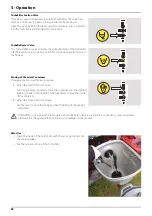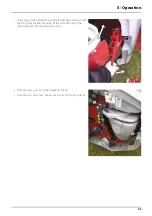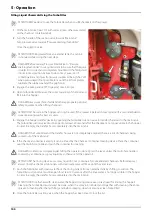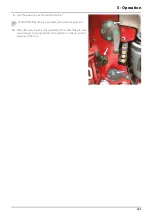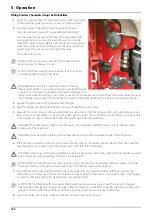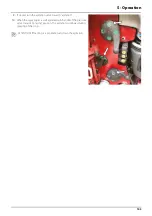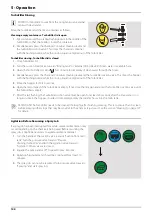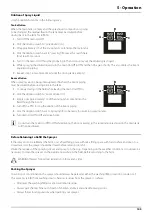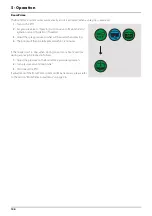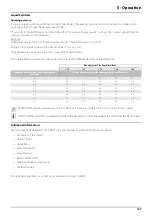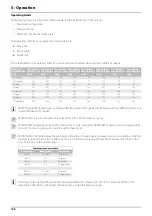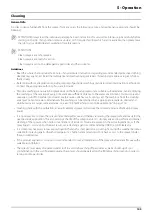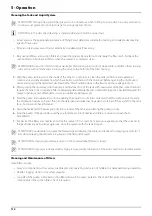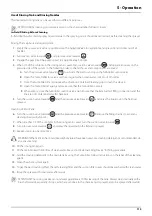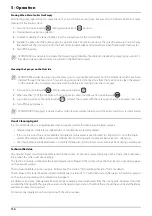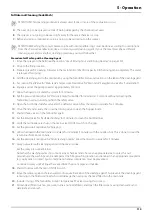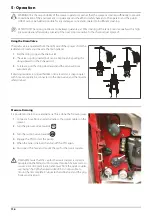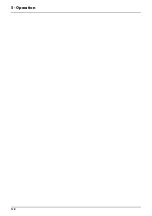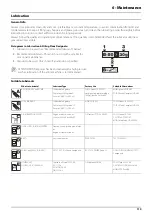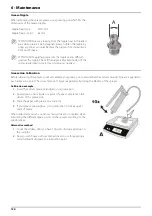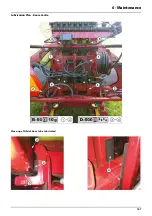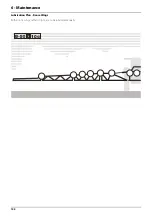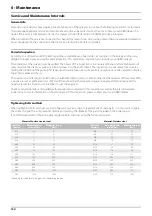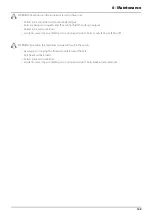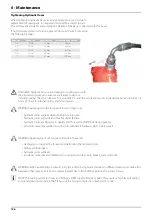
5 - Operation
112
Cleaning the Tank and Liquid System
ATTENTION! Thorough cleaning of the sprayer is to be carried out when shifting to crops, which are very sensitive to
chemicals just sprayed, or prior to storage for a longer period of time.
÷
NOTE! Prior to the described cleaning, a standard cleaning should be carried out.
•
Select and use the appropriate protective clothing. Select detergent suitable for cleaning and suitable deactivating
agents if necessary.
•
Rinse and clean sprayer and tractor externally. Use detergent if necessary.
1.
Remove tank filters and suction filters and clean the sprayer. Be careful not to damage the filter mesh. Put back the
suction filter top. Put back all filters, when the sprayer is completely clean.
ATTENTION! If the suction filter is not put back after this cleaning job, it will not be possible complete other cleaning
jobs, as the suction filter assists in turning the valve at the bottom of the filter housing.
2.
With the pump running, rinse the inside of the tank. Do not forget to clean the tank roof. Rinse and operate all
components and any equipment, which have been in contact with the chemical. Before opening the distribution
valves and spraying the liquid out, decide whether this should be done in the field or on the seepage location.
3.
After spraying the liquid out, stop the pump and fill at least 1/5 of the tank with clean water. Note that some chemicals
require the tank to be completely filled. Add appropriate detergent and/or deactivating agent. Special detergents for
sprayer cleaning is recommended as some also lubricate ball valves etc.
4.
Start the pump and operate all controls enabling the liquid to come into contact with all the components. Operate
the distribution valves as the last thing. Some detergents and deactivating agents work best, if they are left in the tank
for a short period. Check the label.
5.
Drain the tank and let the pump run dry. Rinse inside of the tank, again letting the pump run dry.
6.
Stop the pump. If the pesticides used have a tendency to block nozzles and filters, remove and clean them
immediately.
7.
Put back all the filters and nozzles and store the sprayer. If it is noted, from previous experiences, that the solvents in
the pesticides are particularly aggressive, store the sprayer with the tank lid open.
ATTENTION! It is advisable to increase the forward speed (double, if possible) and reduce the spraying pressure to 1.5
bar, when spraying diluted remaining liquid in the field just sprayed.
ATTENTION! If a cleaning procedure is given on the chemical label, follow it closely.
ATTENTION! If the sprayer is cleaned with a high pressure washer, lubrication of the entire machine is recommended.
Cleaning and Maintenance of Filters
Clean filters ensure:
•
Sprayer components such as valves, diaphragms and operating units are not hindered or damaged during operation.
•
Nozzle clogging do not occur whilst spraying.
•
Long life of the pump. A blocked suction filter will result in pump cavitation. The main filter protecting sprayer
components is the suction filter. Check it regularly.
Summary of Contents for MEGA VPZ MASTER
Page 4: ...1 EU Declaration 4...
Page 10: ...Table of Contents 10...
Page 42: ...2 Safety Notes 42...
Page 68: ...3 Description 68...
Page 118: ...5 Operation 118...
Page 121: ...6 Maintenance 121 Lubrication Plan Boom Centre Close up of Glide Shoes to be Lubricated...
Page 172: ...8 Technical Specifications 172...
Page 176: ...Index 176...
Page 178: ...HARDI INTERNATIONAL A S Herthadalvej 10 DK 4840 N rre Alslev DENMARK...

